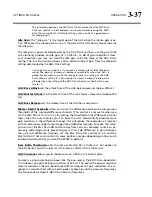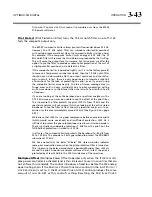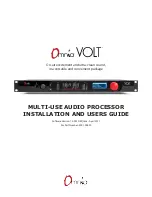
OPTIMOD-FM DIGITAL
OPERATION
3-43
O
VERSHOOT
C
OMPENSATOR
D
RIVE
control is accessible only from the 8500S
PC Remote software.)
Pilot Protect
(Pilot Protection Filter) turns the 19 kHz notch filter on or off. It af-
fects the composite output only.
The 8500S’s composite limiter always protects frequencies above 53 kHz.
However, the 19 kHz notch filter can introduce substantial overshoot
with certain program material when the composite limiter is driven hard.
For example, if the composite limiter limits energy at 6.33 kHz, the 19
kHz notch filter will remove the third harmonic produced by the limiting.
This will cause the output level to increase. For this reason, we offer the
option to use the filter to provide excellent pilot protection at the cost of
a slight potential overshoot, or to defeat the filter.
If the composite limiter is operated lightly (as it is in the factory presets)
to remove a few percent residual overshoot, then the 19 kHz notch filter
should have no observable effect on output overshoot and should re-
main in-circuit. In fact, there is a very good reason to tolerate a slight bit
of overshoot for the sake of protecting the pilot, even if you are using
the composite limiter more heavily. The loss of stereo coverage area (in
fringe areas and in heavy multipath) due to pilot modulation will be
much more obvious to the listeners than the loss of a few tenths of a dB
of loudness.
If you are looking at the entire baseband on a spectrum analyzer with a
0-100 kHz sweep, you may be unable to see the effect of the pilot filter.
This is because the filter protects the pilot
±
250 Hz from 19 kHz and the
spectrum analyzer will not resolve this when looking at the entire stereo
baseband. To see the filter’s effect, zoom the spectrum analyzer in to ex-
amine only the area immediately around 19 kHz. (See
on page
We believe that
±
250 Hz is a good compromise between excessive width
(which would cause overshoot) and insufficient protection.
±
250 Hz is
sufficient to protect the phase-locked loops used in most stereo decoders.
There is actually considerable protection
±
1 kHz from the pilot, but the
full 60 dB of protection is limited to
±
250 Hz.
In all cases, the composite limiter protects the baseband to –80 dB from
55 to 100 kHz. This provides a 2 kHz guard band to protect the RDS/RBDS
subcarrier at 57 kHz.
We have noted that the Belar “Wizard” FM stereo monitor indicates
some pilot modulation even when the pilot protection filter is turned on.
This is because the Belar demodulates a bandwidth wider than
±
250 Hz
around the pilot. A spectrum analyzer will reveal that, in fact, the pilot is
protected by at least 60 dB in this 500 Hz wide area of the spectrum.
Multiplex Offset
(Multiplex Power Offset) operates only when the ITU-412 multi-
plex power controller is activated (and is thus irrelevant to users in countries that do
not enforce this standard). The control introduces a fixed loss before the FM analog
peak limiting chain. If the
M
ULTIPLEX
P
OWER
T
HRESHOLD
control (in the
I
NPUT
/O
UTPUT
/
U
TILITIES
screen) is set to
0
, the
M
ULTIPLEX
P
OWER
O
FFSET
control produces the same
amount of loss (in dB) as this control’s setting. Resetting the
M
ULTIPLEX
P
OWER
Summary of Contents for OPTIMOD-FM 8500S
Page 1: ...Operating Manual OPTIMOD FM 8500S Digital Audio Processor Version 1 0 Software...
Page 7: ...Operating Manual OPTIMOD FM 8500S Digital Audio Processor Version 1 0 Software...
Page 26: ......
Page 56: ......
Page 164: ......
Page 308: ......
Page 310: ...6 28 TECHNICAL DATA ORBAN MODEL 8500S CONTROL BOARD PARTS LOCATOR...
















































